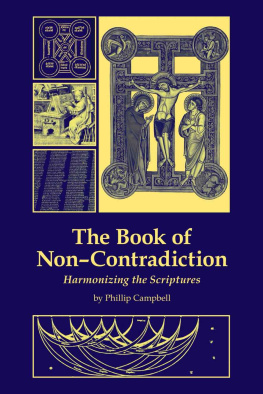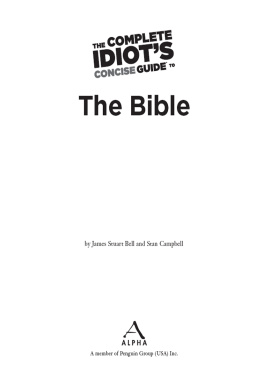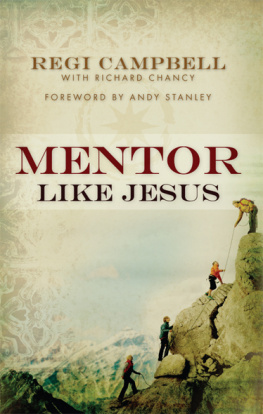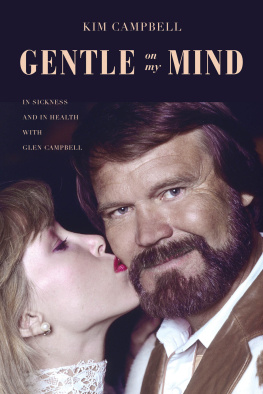Phillip Campbell [Campbell - The Book of Non-Contradiction: Harmonizing the Scriptures
Here you can read online Phillip Campbell [Campbell - The Book of Non-Contradiction: Harmonizing the Scriptures full text of the book (entire story) in english for free. Download pdf and epub, get meaning, cover and reviews about this ebook. year: 2018, publisher: Cruachan Hill Press, genre: Religion. Description of the work, (preface) as well as reviews are available. Best literature library LitArk.com created for fans of good reading and offers a wide selection of genres:
Romance novel
Science fiction
Adventure
Detective
Science
History
Home and family
Prose
Art
Politics
Computer
Non-fiction
Religion
Business
Children
Humor
Choose a favorite category and find really read worthwhile books. Enjoy immersion in the world of imagination, feel the emotions of the characters or learn something new for yourself, make an fascinating discovery.
- Book:The Book of Non-Contradiction: Harmonizing the Scriptures
- Author:
- Publisher:Cruachan Hill Press
- Genre:
- Year:2018
- Rating:4 / 5
- Favourites:Add to favourites
- Your mark:
- 80
- 1
- 2
- 3
- 4
- 5
The Book of Non-Contradiction: Harmonizing the Scriptures: summary, description and annotation
We offer to read an annotation, description, summary or preface (depends on what the author of the book "The Book of Non-Contradiction: Harmonizing the Scriptures" wrote himself). If you haven't found the necessary information about the book — write in the comments, we will try to find it.
Phillip Campbell [Campbell: author's other books
Who wrote The Book of Non-Contradiction: Harmonizing the Scriptures? Find out the surname, the name of the author of the book and a list of all author's works by series.
The Book of Non-Contradiction: Harmonizing the Scriptures — read online for free the complete book (whole text) full work
Below is the text of the book, divided by pages. System saving the place of the last page read, allows you to conveniently read the book "The Book of Non-Contradiction: Harmonizing the Scriptures" online for free, without having to search again every time where you left off. Put a bookmark, and you can go to the page where you finished reading at any time.
Font size:
Interval:
Bookmark:
Contents
The Book ofNonContradiction
Recovering the
Harmony of the Scriptures
By Phillip Campbell

Copyright Information
The Book of NonContradiction
Recovering the Harmony of the Scriptures
By Phillip Campbell
Published by
Cruachan Hill Press 12552 E Michigan Ave.
Grass Lake, MI. 49240
http://cruachanhill.blogspot.com
Copyright 2017 Phillip Campbell
All rights reserved. Primary source text is in the public domain. All other material is all rightsreserved it may not be reproduced, transmitted, or stored in any form by any means electronic, mechanical, recorded, photocopy, or otherwise without prior written permissionfrom the author, except for brief excerpts in articles or critical reviews.
Cover art by Amanda Danziger (http://www.ardanziger.com)
Special thanks to Louisa Zachmann, a student whose love of Scripture helped inspireme to bring this work to fruition.
Introduction
Truth is One
Christianity is a revealed religion. This means that the content of the faith comes not primarilyfrom natural observations about the world and human behavior as do, say, the teachings ofConfucius but rather from a supernatural revelation of God to man. The Christian faith iscertainly enriched and deepened by the application of reason to its teachings, but the fundamentalmessage of Christianity itself is grounded in a miraculous communication between God and thehuman race. It is this communication that tradition has named Divine Revelation.
Christianity is not the only religion that claims to be revealed; Islam and Judaism are alsoconsidered revealed religions, inasmuch as they ground their religious claims in supernaturalrevelations of God to man. But Christianity is certainly the only religion where the revelation is aperson Jesus Christ. In many and various ways God spoke of old to our fathers by the prophets,but in these last days he has spoken to us by a Son (Heb. 1:12). As the Catechism of the CatholicChurch says, God has said everything in His Word (CCC 65). Though God spoke through theprophets of the Old Testament at various times, in the person of Christ we have the final,consummate, definitive revelation of God.
Gods dealing with man, whether in the Old Testament or through the sending of His Son in theNew, is commonly referred to as salvation history. The Sacred Scriptures faithfully recount thesalvation history of the human race, from the creation of man and the calling of Abraham all theway to the salvific death of Christ on the cross and the foundation of the Church, the universalKingdom of God. Though certainly the Catholic faith has always recognized other sources oftheological truth beside the Scriptures (Sacred Tradition and the authoritative teachings of theMagisterium) nevertheless, Sacred Scripture has always been considered the primal content fromwhich theology draws its propositions. From the Apostolic Fathers to St. Augustine and on toAquinas and the medievals, theology was essentially the study of and commentary on the sacredpage.
Theology is grounded in Scripture, but Scripture and theology are two different things. In acertain sense, theology developed as Christians tried to systematize their faith and develop acoherent method for explaining the Scriptures. This was necessary because the Scriptures do notpresent theological truth in any systematic way. They are a record of Gods particular dealings withmankind, not a manual of dogmatic theology. They teach theological truths inerrantly, but they donot necessarily do so in an organized way. This is perfectly reasonable if we understand thenarrative nature of the Scriptures. They are essentially like a divine biography, giving a broadoverview of salvation history, but in a way that is chronological and piecemeal. Theology developedas a means of organizing these pieces thematically.
Imagine we were reading a biography of Abraham Lincoln. Understood as a biography thatis, a work that is meant to tell us sequentially about the course of Lincolns life and work such abook would be a fine way to learn about Lincoln, and we would probably gather many insights intohis thought as well. But we would not turn to a biography for a topical treatment of Lincolns ideas.For example, a biography would not necessarily give us a comprehensive analysis of Lincolns viewon states rights. We may be able to infer his opinions through the biography to some degree, butit would not present a systematic treatment. For that, we would turn to a book that treated Lincolnspolitical ideology systematically.
This is the same problem theologians run into when reading the Sacred Scriptures. Setting asidethe debate as to whether the Scriptures are a materially sufficient or formally sufficient source forthe corpus of Catholic theology (which is beyond the scope of this essay), the fact remains that theScriptures do not teach everything in an explicit manner, and many things in the Bible are merelystated with no explanation offered for them in the text.
We could offer several examples of challenging aspects of the biblical narrative. The Gospelwriters often record different aspects of our Lords life, sometimes such that it is hard to see howthey go together. God acts a certain way in one situation and then mysteriously acts differently inanother seemingly similar scenario. For example, God rejects Sauls kingship after Saul commitsthe trivial sin of offering a sacrifice without the presence of Samuel, but He forgives David the sinsof adultery and murder. Different accounts of the same event sometimes present differentexplanations for that event; what one text attributes to the providence of God another says is theagency of the devil. Many passages use the same word but in different contexts. The challenges aremany.
These difficulties are nothing new to Christians. Some of the earliest Christian apologeticalworks were written to explain difficult passages. St. Justin Martyrs Dialogue with Trypho is amasterful exegesis of difficult Old Testament passages that Jews had been accustomed to invokingagainst the claims of the Church. St. Justin methodically sorts through these passages, interpretsthem in light of the New Testament, and reconciles them with Christian theology.
The first attempt to reconcile the accounts of the Gospels was the Diatessaron by the 2nd centuryChurch Father Tatian. The Diatessaron featured the four Gospels combined into a single narrativework. Its purpose appears not to have been to show how the Gospels were in harmony as much asto simply create a single Gospel text that could be referenced instead of having to consult fourdifferent manuscripts. A more notable work is St. Augustines On the Harmony of the Gospels. Inthis work, St. Augustine examines different passages in the Gospels and attempts to reconcile themin order to harmonize the four accounts of Jesus life. St. Augustine taught that differences in theGospel texts are only apparent, and that the Gospel writers chose to emphasize different aspectsof Christs life because they meant to exemplify different facets of Christs identity: Matthew onroyalty, Mark on humanity, Luke on priesthood, and John on divinity. This is the first major workin what would be a long Christian tradition of harmonizing the Scriptures.
Various other Gospel Harmonies would appear throughout the Middle Ages, most of whichwere essentially rehashes of the Diatessaron or Augustine. Meanwhile, Christians developed othermeans of systematizing and harmonizing the Churchs theological tradition. The canonicalmovement of the 11th13th centuries sorted through the vast trove of ecclesiastical canons from thefirst millennium in a laborious effort to reconcile them into a single body of legislation. TheScholastic movement in the universities did the same thing with the various theological andphilosophical sources of antiquity, demonstrating that, despite differences in style and emphasis,St. Paul, St. Augustine, Peter Lombard and others all essentially taught the same thing, and that thefaith could be reconciled with some of the greatest insights of the pagan philosophers, most notablyAristotle.
Next pageFont size:
Interval:
Bookmark:
Similar books «The Book of Non-Contradiction: Harmonizing the Scriptures»
Look at similar books to The Book of Non-Contradiction: Harmonizing the Scriptures. We have selected literature similar in name and meaning in the hope of providing readers with more options to find new, interesting, not yet read works.
Discussion, reviews of the book The Book of Non-Contradiction: Harmonizing the Scriptures and just readers' own opinions. Leave your comments, write what you think about the work, its meaning or the main characters. Specify what exactly you liked and what you didn't like, and why you think so.








